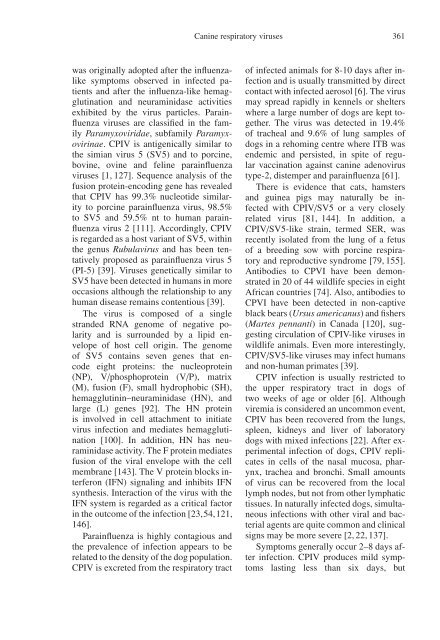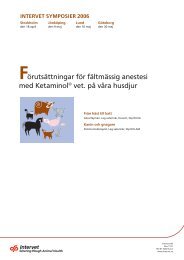KVÄLLSSYMPOSIUM 2008 Vaccinering av hund och katt
KVÄLLSSYMPOSIUM 2008 Vaccinering av hund och katt
KVÄLLSSYMPOSIUM 2008 Vaccinering av hund och katt
You also want an ePaper? Increase the reach of your titles
YUMPU automatically turns print PDFs into web optimized ePapers that Google loves.
was originally adopted after the influenzalike<br />
symptoms observed in infected patients<br />
and after the influenza-like hemagglutination<br />
and neuraminidase activities<br />
exhibited by the virus particles. Parainfluenza<br />
viruses are classified in the family<br />
Paramyxoviridae, subfamily Paramyxovirinae.<br />
CPIV is antigenically similar to<br />
the simian virus 5 (SV5) and to porcine,<br />
bovine, ovine and feline parainfluenza<br />
viruses [1, 127]. Sequence analysis of the<br />
fusion protein-encoding gene has revealed<br />
that CPIV has 99.3% nucleotide similarity<br />
to porcine parainfluenza virus, 98.5%<br />
to SV5 and 59.5% nt to human parainfluenza<br />
virus 2 [111]. Accordingly, CPIV<br />
is regarded as a host variant of SV5, within<br />
the genus Rubul<strong>av</strong>irus and has been tentatively<br />
proposed as parainfluenza virus 5<br />
(PI-5) [39]. Viruses genetically similar to<br />
SV5 h<strong>av</strong>e been detected in humans in more<br />
occasions although the relationship to any<br />
human disease remains contentious [39].<br />
The virus is composed of a single<br />
stranded RNA genome of negative polarity<br />
and is surrounded by a lipid envelope<br />
of host cell origin. The genome<br />
of SV5 contains seven genes that encode<br />
eight proteins: the nucleoprotein<br />
(NP), V/phosphoprotein (V/P), matrix<br />
(M), fusion (F), small hydrophobic (SH),<br />
hemagglutinin–neuraminidase (HN), and<br />
large (L) genes [92]. The HN protein<br />
is involved in cell attachment to initiate<br />
virus infection and mediates hemagglutination<br />
[100]. In addition, HN has neuraminidase<br />
activity. The F protein mediates<br />
fusion of the viral envelope with the cell<br />
membrane [143]. The V protein blocks interferon<br />
(IFN) signaling and inhibits IFN<br />
synthesis. Interaction of the virus with the<br />
IFN system is regarded as a critical factor<br />
in the outcome of the infection [23,54,121,<br />
146].<br />
Parainfluenza is highly contagious and<br />
the prevalence of infection appears to be<br />
related to the density of the dog population.<br />
CPIV is excreted from the respiratory tract<br />
Canine respiratory viruses 361<br />
of infected animals for 8-10 days after infection<br />
and is usually transmitted by direct<br />
contact with infected aerosol [6]. The virus<br />
may spread rapidly in kennels or shelters<br />
where a large number of dogs are kept together.<br />
The virus was detected in 19.4%<br />
of tracheal and 9.6% of lung samples of<br />
dogs in a rehoming centre where ITB was<br />
endemic and persisted, in spite of regular<br />
vaccination against canine adenovirus<br />
type-2, distemper and parainfluenza [61].<br />
There is evidence that cats, hamsters<br />
and guinea pigs may naturally be infected<br />
with CPIV/SV5 or a very closely<br />
related virus [81, 144]. In addition, a<br />
CPIV/SV5-like strain, termed SER, was<br />
recently isolated from the lung of a fetus<br />
of a breeding sow with porcine respiratory<br />
and reproductive syndrome [79, 155].<br />
Antibodies to CPVI h<strong>av</strong>e been demonstrated<br />
in 20 of 44 wildlife species in eight<br />
African countries [74]. Also, antibodies to<br />
CPVI h<strong>av</strong>e been detected in non-captive<br />
black bears (Ursus americanus) and fishers<br />
(Martes pennanti) in Canada [120], suggesting<br />
circulation of CPIV-like viruses in<br />
wildlife animals. Even more interestingly,<br />
CPIV/SV5-like viruses may infect humans<br />
and non-human primates [39].<br />
CPIV infection is usually restricted to<br />
the upper respiratory tract in dogs of<br />
two weeks of age or older [6]. Although<br />
viremia is considered an uncommon event,<br />
CPIV has been recovered from the lungs,<br />
spleen, kidneys and liver of laboratory<br />
dogs with mixed infections [22]. After experimental<br />
infection of dogs, CPIV replicates<br />
in cells of the nasal mucosa, pharynx,<br />
trachea and bronchi. Small amounts<br />
of virus can be recovered from the local<br />
lymph nodes, but not from other lymphatic<br />
tissues. In naturally infected dogs, simultaneous<br />
infections with other viral and bacterial<br />
agents are quite common and clinical<br />
signs may be more severe [2, 22, 137].<br />
Symptoms generally occur 2–8 days after<br />
infection. CPIV produces mild symptoms<br />
lasting less than six days, but





